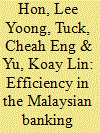|
|
|
Sort Order |
|
|
|
Items / Page
|
|
|
|
|
|
|
| Srl | Item |
| 1 |
ID:
103951


|
|
|
| 2 |
ID:
151562


|
|
|
|
|
| Summary/Abstract |
Since the early 2000s, the Chinese government has undertaken a series of reforms in the health sector. Among these, the three most important have been concerned with medical insurance, hospital administration, and pharmaceutical policies. The aims of these reforms were to extend health insurance coverage, to increase the activities and the efficiency of the health establishments, and to improve patient care. This article focuses on two components of these reforms: the development of health insurance in rural areas and the policy on essential medicines in conjunction with hospital reforms. Our longstanding co-operation with a research team from Weifang University and with the Weifang Health Bureau allowed us to follow these reforms and collect data (primary source) from a sample of township hospitals from Weifang Prefecture. Those data allowed us to study their effects on health facilities' level of activity and efficiency. This article provides an overview of studies we carried out on these issues over the period from 2000 to 2012. Our analyses were mainly based on non-parametric models (Data Envelopment Analysis, Malmquist Index, and partial frontiers) and impact analyses, coupled with interviews with hospital staff and medical authorities. Results show that the development of health insurance in rural areas had a positive effect in greatly increasing the activities of the hospitals covered by our study. On the other hand, it did not have a positive influence on their efficiency, which declined in the period concerned. This result is to be explained by the fact that, even though staff activity increased, it remained low, since the observed increase in activity was not sufficient to make up for the parallel increase in staff numbers. Similarly, reforms in the hospital and pharmaceutical sectors had no effect on the township hospitals of our survey. In fact, in order to compensate for the observed reduction of hospital resources following the introduction of the reforms, on the one hand the government increased the subsidies allocated to township hospitals, and on the other hand the hospitals strongly innovated in sophisticated and expensive care, to the benefit of a relatively small number of patients. Therefore, there were some very positive steps forward, but they still call for a more nuanced assessment of the effects of the reforms.
|
|
|
|
|
|
|
|
|
|
|
|
|
|
|
|
| 3 |
ID:
106242


|
|
|
|
|
| Publication |
2011.
|
| Summary/Abstract |
Since the implementation of health care reforms, much has been documented regarding the practices and behavior of hospitals or health profession in China. While these documentations pointed to various problems arising from the reforms, a systematic analysis is rarely found. Based on five years' data, the present study aims at providing empirical evidence of inefficiency of hospitals in China. Using the data envelopment analysis, the sources of inefficiency were examined. Echoing the unnecessary care, over-prescription of drugs and the adoption of high-tech treatments since the implementation of health care reforms, the sampled hospitals were found quite inefficient and pure technical inefficiency played a dominant role in driving the inefficiency of hospitals. Combining the panel nature of the data and the Malmquist Index computation, hospitals had experienced productivity growth between 2004 and 2008. Mirroring the behavior of hospitals, technological progress was the underlying force for the growth and the deterioration in efficiency change was found. The results summarized by region revealed that the stage of economic development and the efficiency performance of hospital did not necessarily go hand in hand.
|
|
|
|
|
|
|
|
|
|
|
|
|
|
|
|
|
|
|
|
|